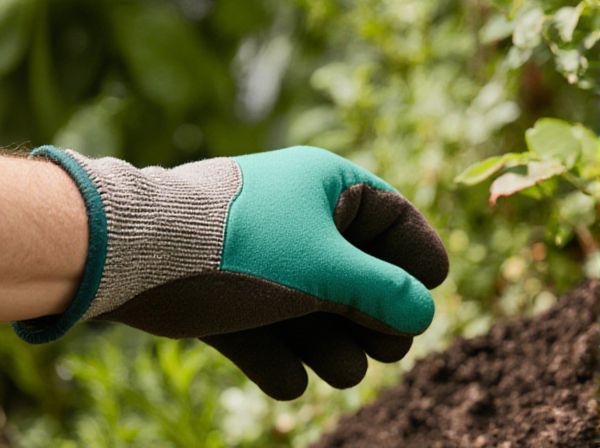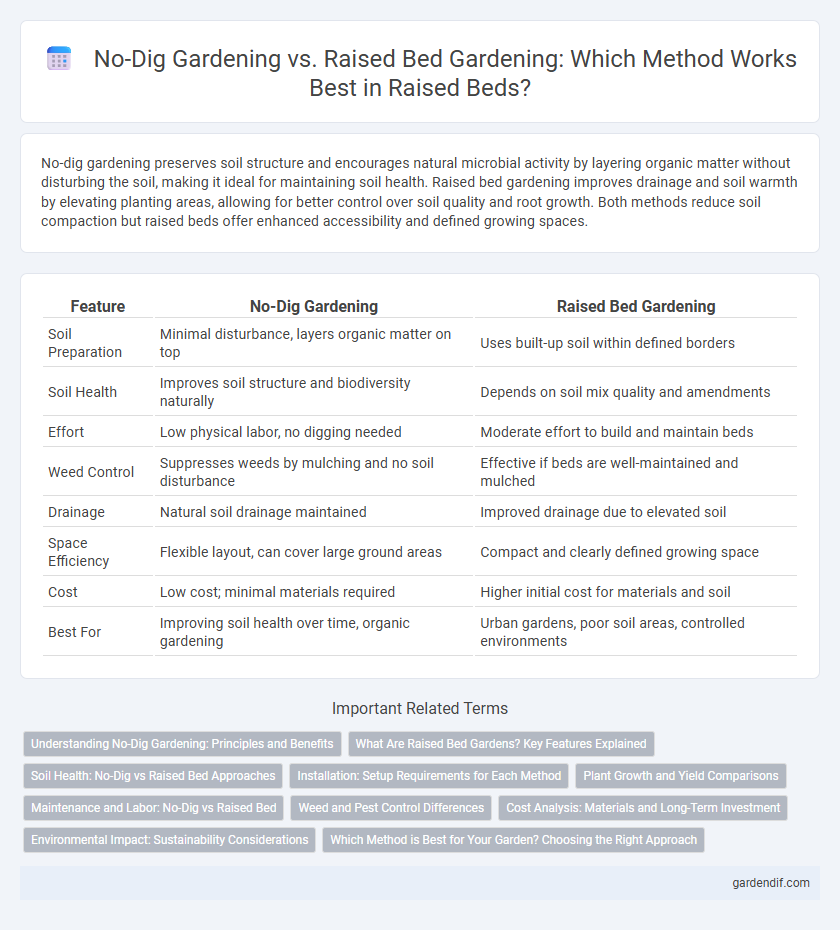
No-dig gardening vs Raised bed gardening Illustration
No-dig gardening preserves soil structure and encourages natural microbial activity by layering organic matter without disturbing the soil, making it ideal for maintaining soil health. Raised bed gardening improves drainage and soil warmth by elevating planting areas, allowing for better control over soil quality and root growth. Both methods reduce soil compaction but raised beds offer enhanced accessibility and defined growing spaces.
Table of Comparison
| Feature | No-Dig Gardening | Raised Bed Gardening |
|---|---|---|
| Soil Preparation | Minimal disturbance, layers organic matter on top | Uses built-up soil within defined borders |
| Soil Health | Improves soil structure and biodiversity naturally | Depends on soil mix quality and amendments |
| Effort | Low physical labor, no digging needed | Moderate effort to build and maintain beds |
| Weed Control | Suppresses weeds by mulching and no soil disturbance | Effective if beds are well-maintained and mulched |
| Drainage | Natural soil drainage maintained | Improved drainage due to elevated soil |
| Space Efficiency | Flexible layout, can cover large ground areas | Compact and clearly defined growing space |
| Cost | Low cost; minimal materials required | Higher initial cost for materials and soil |
| Best For | Improving soil health over time, organic gardening | Urban gardens, poor soil areas, controlled environments |
Understanding No-Dig Gardening: Principles and Benefits
No-dig gardening emphasizes maintaining soil structure by avoiding tilling, which preserves beneficial microorganisms and reduces weed growth. This method improves soil aeration and moisture retention, promoting healthier plant roots compared to traditional raised bed gardening. Benefits include enhanced soil fertility, minimal disturbance, and reduced labor, making it an eco-friendly alternative for sustainable food production.
What Are Raised Bed Gardens? Key Features Explained
Raised bed gardens consist of soil enclosed in framed structures, typically made from wood, stone, or metal, designed to improve drainage and soil quality. Key features include elevated soil levels that reduce compaction, enhanced root growth, and better control over soil amendments and pest management. Unlike no-dig gardening, raised beds provide a contained environment that facilitates easier maintenance and optimized plant health through improved soil conditions.
Soil Health: No-Dig vs Raised Bed Approaches
No-dig gardening preserves soil structure by minimizing disturbance, enhancing microbial activity and organic matter retention, which supports long-term soil fertility. Raised bed gardening improves soil drainage and root aeration, but regular tilling or soil replacement can disrupt soil ecosystems and microbial diversity. Both methods offer distinct benefits for soil health, with no-dig favoring natural regeneration and raised beds allowing targeted amendments and crop rotation.
Installation: Setup Requirements for Each Method
No-dig gardening requires minimal setup, focusing on layering organic materials directly onto the soil without the need for structural components, making it ideal for quick installation and soil health preservation. Raised bed gardening involves constructing a contained garden space using materials like wood, metal, or stone, requiring time for building frames and filling them with quality soil and amendments. Installation of raised beds demands more upfront effort and cost but offers improved drainage, soil control, and accessibility compared to no-dig methods.
Plant Growth and Yield Comparisons
No-dig gardening preserves soil structure and microbial life, promoting robust root development and improving nutrient uptake, which often leads to healthier plants and enhanced growth. Raised bed gardening offers better drainage and soil control, resulting in higher yields and more efficient space usage by optimizing soil conditions and reducing compaction. Studies indicate raised beds generally produce greater crop yields compared to no-dig methods, though no-dig beds excel in improving soil biology and long-term fertility.
Maintenance and Labor: No-Dig vs Raised Bed
No-dig gardening minimizes labor by eliminating soil turning, relying on natural decomposition and surface mulch to maintain soil health, resulting in less weed control and disturbance. Raised bed gardening requires periodic soil turning, nutrient replenishment, and structural upkeep, demanding more regular maintenance but offering improved drainage and root growth control. Choosing between these methods depends on the gardener's preference for labor intensity and long-term soil management priorities.
Weed and Pest Control Differences
No-dig gardening reduces weed growth by maintaining an undisturbed soil layer, which preserves beneficial microorganisms that suppress weed seeds and pest populations naturally. Raised bed gardening allows for better control over soil quality and drainage, but it may require more frequent weeding and pest management due to exposed soil surfaces. Both methods support organic pest control strategies, yet no-dig gardens tend to experience fewer weed invasions and pest outbreaks because of less soil disturbance.
Cost Analysis: Materials and Long-Term Investment
No-dig gardening typically requires minimal initial investment, utilizing existing soil and organic mulch, reducing material costs to around $50-$150 for basic tools and compost. Raised bed gardening demands a higher upfront expenditure between $150-$500, factoring in lumber, hardware, and quality soil, but offers improved soil control and longevity that can justify long-term returns. Over time, raised beds enhance resource efficiency and crop yield, potentially offsetting initial costs through higher productivity and reduced maintenance.
Environmental Impact: Sustainability Considerations
No-dig gardening enhances soil health by minimizing disturbance, preserving soil organisms, and reducing carbon release, which promotes long-term sustainability. Raised bed gardening can improve water efficiency and control soil quality but may require additional materials like wood or metal, impacting environmental footprint depending on resource sourcing. Prioritizing organic mulches and sustainably sourced materials in both methods significantly optimizes environmental benefits and supports eco-friendly gardening practices.
Which Method is Best for Your Garden? Choosing the Right Approach
No-dig gardening enhances soil structure and microbial life by minimizing soil disturbance, ideal for nutrient retention and weed control. Raised bed gardening offers improved drainage, soil warming, and ease of access, perfect for small spaces and controlled environments. Selecting the best method depends on garden goals, soil condition, and maintenance preferences to optimize plant health and productivity.
No-dig gardening vs Raised bed gardening Infographic

 gardendif.com
gardendif.com